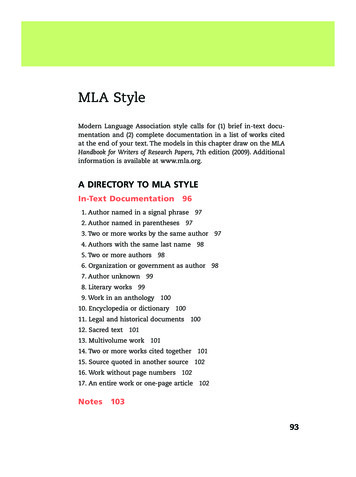
Transcription
MLA StyleModern Language Association style calls for (1) brief in-text documentation and (2) complete documentation in a list of works citedat the end of your text. The models in this chapter draw on the MLAHandbook for Writers of Research Papers, 7th edition (2009). Additionalinformation is available at www.mla.org.A DIRECTORY TO MLA STYLEIn-Text Documentation961. Author named in a signal phrase 972. Author named in parentheses973. Two or more works by the same author4. Authors with the same last name5. Two or more authors986. Organization or government as author7. Author unknown8. Literary works9899999. Work in an anthology10010. Encyclopedia or dictionary10011. Legal and historical documents12. Sacred text979810010113. Multivolume work10114. Two or more works cited together15. Source quoted in another source16. Work without page numbers10110210217. An entire work or one-page article 102Notes103938038 B2.indd 9312/6/10 8:42 PM
94MLAMLA STYLEList of Works Cited103BOOKS 103Documentation Map: Book1. One author1051042. Two or more works by the same author(s)3. Two or three authors1064. Four or more authors1065. Organization or government as author1041066. Anthology 1077. Work(s) in an anthology8. Author and editor1071089. No author or editor10810. Translation 10811. Graphic narrative10912. Foreword, introduction, preface, or afterword10913. Multivolume work 10914. Article in a reference book 10915. Book in a series16. Sacred text11011017. Book with title within the title18. Edition other than the first19. Republished work11111111120. Publisher and imprint111PERIODICALS 112Documentation Map: Article in a Journal 113Documentation Map: Article in a Magazine 11421. Article in a journal11222. Article in a journal numbered by issue23. Article in a magazine8038 B2.indd 9411211512/6/10 8:42 PM
A Directory to MLA Style24. Article in a daily newspaper25. Unsigned article26. EditorialMLA9511511511627. Letter to the editor11628. Review 116online SOURCES 116Documentation Map: Work from a Website 118Documentation Map: Article Accessed through a Database29. Entire website11730. Work from a website11931. Online book or part of a book11932. Article in an online scholarly journal33. Article in an online newspaper34. Article in an online magazine35. Blog entry11912012012036. Article accessed through a database37. Online editorial12012138. Online film review39. Email12212112140. Posting to an online forum12141. Article in an online reference work42. Wiki entry43. Podcast123123123OTHER KINDS OF SOURCES (INCLUDING ONLINE VERSIONS)12344. Advertisement 12345. Art12446. Cartoon12447. Dissertation12448. CD-ROM or DVD-ROM49. Film, DVD, or video clip8038 B2.indd 9512512512/6/10 8:42 PM
96MLA-aMLA STYLE50. Broadcast interview12651. Published interview12652. Personal interview12653. Unpublished letter12654. Published letter12655. Map or chart 12756. Musical score12757. Sound recording58. Oral presentation12712859. Paper from proceedings of a conference12860. Performance 12861. Television or radio program12862. Pamphlet, brochure, or press release63. Legal source12912964. MP3, JPEG, PDF, or other digital file129CITing SOURCES not covered by MLA 130Formatting a PaperSample Pages130132Throughout this chapter, you’ll find models and examples that arecolor-coded to help you see how writers include source information in their texts and lists of works cited: tan for author or editor,yellow for title, gray for publication information: place of publication,publisher, date of publication, page number(s), and so on.MLA-a In-Text DocumentationBrief documentation in your text makes clear to your reader whatyou took from a source and where in the source you found theinformation.8038 B2.indd 9612/6/10 8:42 PM
In-Text DocumentationMLA-a97In your text, you have three options for citing a source: quoting ,paraphrasing , and summarizing . As you cite each source, you willneed to decide whether or not to name the author in a signal phrase —“as Toni Morrison writes” — or in parentheses — “(Morrison 24).”The first examples in this chapter show basic in-text citationsof a work by one author. Variations on those examples follow. Theexamples illustrate the MLA style of using quotation marks aroundtitles of short works and italicizing titles of long works.1. author named in a signal phraseIf you mention the author in a signal phrase, put only the pagenumber(s) in parentheses. Do not write page or p.McCullough describes John Adams’s hands as those of someoneused to manual labor (18).2. author named in parenthesesIf you do not mention the author in a signal phrase, put his or herlast name in parentheses along with the page number(s). Do not usepunctuation between the name and the page number(s).Adams is said to have had “the hands of a man accustomed topruning his own trees, cutting his own hay, and splitting hisown firewood” (McCullough 18).Whether you use a signal phrase and parentheses or parenthesesonly, try to put the parenthetical citation at the end of the sentenceor as close as possible to the material you’ve cited without awkwardly interrupting the sentence. Notice that in the example above,the parenthetical reference comes after the closing quotation marksbut before the period at the end of the sentence.3. two or more works by the same authorIf you cite multiple works by one author, include the title of the workyou are citing either in the signal phrase or in parentheses. Give thefull title if it’s brief; otherwise, give a short version.8038 B2.indd 9712/6/10 8:42 PM
98MLA-aMLA STYLEKaplan insists that understanding power in the Near Eastrequires “Western leaders who know when to intervene, and doso without illusions” (Eastward 330).Include a comma between author and title if you include both inthe parentheses.Understanding power in the Near East requires “Western leaderswho know when to intervene, and do so without illusions”(Kaplan, Eastward 330).4. authors with the same last nameGive the author’s first name in any signal phrase or the author’s firstinitial in the parenthetical reference.Imaginative applies not only to modern literature (E. Wilson)but also to writing of all periods, whereas magical is often usedin writing about Arthurian romances (A. Wilson).5. two or more authorsFor a work by two or three authors, name all the authors, either ina signal phrase or in the parentheses.Carlson and Ventura’s stated goal is to introduce Julio Cortázar,Marjorie Agosín, and other Latin American writers to anaudience of English-speaking adolescents (v).For a work with four or more authors, either mention all their namesor include just the name of the first author followed by et al., Latinfor “and others.”One popular survey of American literature breaks the contentsinto sixteen thematic groupings (Anderson et al. A19–24).6. organization or government as authorCite the organization either in a signal phrase or in parentheses. It’sacceptable to shorten long names.8038 B2.indd 9812/6/10 8:42 PM
In-Text DocumentationMLA-a99The U.S. government can be direct when it wants to be. Forexample, it sternly warns, “If you are overpaid, we will recoverany payments not due you” (Social Security Administration 12).7. author unknownIf you don’t know the author, use the work’s title or a shortened version of the title in the parentheses.A powerful editorial in last week’s paper asserts that healthyliver donor Mike Hurewitz died because of “frightening” faultypostoperative care (“Every Patient’s Nightmare”).8. literary worksWhen referring to literary works that are available in many differenteditions, cite the page numbers from the edition you are using, followed by information that will let readers of any edition locate thetext you are citing.novels. Give the page and chapter number.In Pride and Prejudice, Mrs. Bennet shows no warmth towardJane and Elizabeth when they return from Netherfield (105;ch. 12).verse plays. Give the act, scene, and line numbers; separate themwith periods.Macbeth continues the vision theme when he addresses theGhost with “Thou hast no speculation in those eyes / Whichthou dost glare with” (3.3.96–97).poems. Give the part and the line numbers (separated by periods). If apoem has only line numbers, use the word line(s) in the first reference.Whitman sets up not only opposing adjectives but also opposingnouns in “Song of Myself” when he says, “I am of old and8038 B2.indd 9912/6/10 8:42 PM
100MLA-aMLA STYLEyoung, of the foolish as much as the wise, / . . . a child as wellas a man” (16.330–32).One description of the mere in Beowulf is “not a pleasantplace!” (line 1372). Later, the label is “the awful place” (1378).9. work in an anthologyName the author(s) of the work, not the editor of the anthology —either in a signal phrase or in parentheses.“It is the teapots that truly shock,” according to Cynthia Ozickin her essay on teapots as metaphor (70).In In Short: A Collection of Creative Nonfiction, readers will findboth an essay on Scottish tea (Hiestand) and a piece on teapotsas metaphors (Ozick).10. ENCYCLOPEDIA OR DICTIONARYCite an entry in an encyclopedia or dictionary using the author’sname, if available. For an entry in a reference work without an author,give the entry’s title in parentheses. If entries are arranged alphabetically, no page number is needed.Katz notes that before Spartacus, Kubrick went without workfor two years (“Stanley Kubrick”).11. LEGAL AND HISTORICAL DOCUMENTSFor legal cases and acts of law, name the case or act in a signal phraseor in parentheses. Italicize the name of a legal case.In 2005, the Supreme Court confirmed in MGM Studios, Inc. v.Grokster, Ltd. that peer-to-peer file sharing is illegal copyright infringement.Do not italicize the titles of laws, acts, or well-known historical documents such as the Declaration of Independence. Give the title and anyrelevant articles and sections in parentheses. It’s okay to use commonabbreviations such as art. or sec. and to abbreviate well-known titles.8038 B2.indd 10012/6/10 8:42 PM
In-Text DocumentationMLA-a101The United States Constitution grants the president the right tomake recess appointments (US Const., art. 2, sec. 2).12. sacred textWhen citing sacred texts such as the Bible or the Qur’an, give thetitle of the edition used, and in parentheses give the book, chapter,and verse (or their equivalent), separated by periods. MLA style recommends that you abbreviate the names of the books of the Biblein parenthetical references.The wording from The New English Bible follows: “In thebeginning of creation, when God made heaven and earth, theearth was without form and void, with darkness over the faceof the abyss, and a mighty wind that swept over the surface ofthe waters” (Gen. 1.1–2).13. multivolume workIf you cite more than one volume of a multivolume work, each timeyou cite one of the volumes, give the volume and the page numbersin parentheses, separated by a colon.Sandburg concludes with the following sentence about thosepaying last respects to Lincoln: “All day long and through thenight the unbroken line moved, the home town having itsfarewell” (4: 413).If your works-cited list includes only a single volume of a multivolume work, give just the page number in parentheses.14. two or more works cited togetherIf you’re citing two or more works closely together, you will sometimes need to provide a parenthetical citation for each one.Tanner (7) and Smith (viii) have looked at works from a culturalperspective.8038 B2.indd 10112/6/10 8:42 PM
102MLA-aMLA STYLEIf you include both in the same parentheses, separate the referenceswith a semicolon.Critics have looked at both Pride and Prejudice and Frankensteinfrom a cultural perspective (Tanner 7; Smith viii).15. source quoted in another sourceWhen you are quoting text that you found quoted in another source,use the abbreviation qtd. in in the parenthetical reference.Charlotte Brontë wrote to G. H. Lewes: “Why do you like MissAusten so very much? I am puzzled on that point” (qtd. inTanner 7).16. WORK WITHOUT PAGE NUMBERSFor works without page numbers, including many online sources,identify the source using the author or other information either in asignal phrase or in parentheses.Studies reported in Scientific American and elsewhere show thatmusic training helps children to be better at multitasking laterin life (“Hearing the Music”).If the source has paragraph or section numbers, use them with theabbreviation par. or sec.: (“Hearing the Music,” par. 2). If an online workis available as a PDF, cite its page numbers in parentheses.17. an entire work or one-page articleIf you cite an entire work rather than a part of it, or if you cite a singlepage article, identify the author in a signal phrase or in parentheses.There’s no need to include page numbers.At least one observer considers Turkey and Central Asiaexplosive (Kaplan).8038 B2.indd 10212/6/10 8:42 PM
List of Works CitedMLA-c103MLA-b NotesSometimes you may need to give information that doesn’t fit intothe text itself — to thank people who helped you, provide additionaldetails, refer readers to other sources, or to add comments aboutsources. Such information can be given in a footnote (at the bottomof the page) or an endnote (on a separate page with the heading Notesjust before your works-cited list). Put a superscript number at theappropriate point in your text, signaling to readers to look for thenote with the corresponding number. If you have multiple notes,number them consecutively throughout your paper.TEXTThis essay will argue that small liberal arts colleges should notrecruit athletes and, more specifically, that giving studentathletes preferential treatment undermines the largereducational goals.1NOTE1I want to thank all those who have contributed to mythinking on this topic, especially my classmates and my teachersMarian Johnson and Diane O’Connor.MLA-c List of Works CitedA works-cited list provides full bibliographic information for everysource cited in you text. See page 132 for guidelines on preparing thislist; for a sample works-cited list, see page 135. BooksFor most books, you’ll need to provide information about the author;the title and any subtitle; and the place of publication, publisher, anddate. At the end of the citation provide the medium — Print.8038 B2.indd 10312/6/10 8:42 PM
104MLA-cMLA STYLEimportant details for citing books authors: Include the author’s middle name or initials, if any. t itles: Capitalize all principal words in titles and subtitles. Donot capitalize a, an, the, to, or any prepositions or coordinatingconjunctions unless they are the first or last word of a title orsubtitle. publication place: If there’s more than one city, use the first. p ublisher: Use a short form of the publisher’s name (Norton forW. W. Norton & Company, Yale UP for Yale University Press). dates: If more than one year is given, use the most recent one.1. one authorAuthor’s Last Name, First Name. Title. Publication City: Publisher,Year of publication. Medium.Anderson, Curtis. The Long Tail: Why the Future of Business Is SellingLess of More. New York: Hyperion, 2006. Print.2. TWO OR MORE WORKS BY THE SAME AUTHOR(S)Give the author’s name in the first entry, and then use three hyphensin the author slot for each of the subsequent works, listing themalphabetically by the first important word of each title.Author’s Last Name, First Name. Title That Comes First Alphabetically.Publication City: Publisher, Year of publication. Medium.---. Title That Comes Next Alphabetically. Publication City: Publisher,Year of publication. Medium.Kaplan, Robert D. The Coming Anarchy: Shattering the Dreams ofthe Post Cold War. New York: Random, 2000. Print.---. Eastward to Tartary: Travels in the Balkans, the Middle East, andthe Caucasus. New York: Random, 2000. Print.8038 B2.indd 10412/6/10 8:42 PM
mla-cDocumentation map (mla)book105TitleSubtitleAuthorYear of publicationPublisherPublication CityEkirch, A. Roger. At Day’s Close: Night in Times Past. New York:Norton, 2005. Print.8038 B2.indd 10512/6/10 8:42 PM
106MLA-cMLA STYLE3. TWO OR THREE AUTHORSFirst Author’s Last Name, First Name, Second Author’s First and LastNames, and Third Author’s First and Last Names. Title.Publication City: Publisher, Year of publication. Medium.Malless, Stanley, and Jeffrey McQuain. Coined by God: Words andPhrases That First Appear in the English Translations of theBible. New York: Norton, 2003. Print.Sebranek, Patrick, Verne Meyer, and Dave Kemper. Writers INC: AGuide to Writing, Thinking, and Learning. Burlington: WriteSource, 1990. Print.4. FOUR OR MORE AUTHORSYou may give each author’s name or the name of the first authoronly, followed by et al., Latin for “and others.”First Author’s Last Name, First Name, Second Author’s First and LastNames, Third Author’s First and Last Names, and Final Author’sFirst and Last Names. Title. Publication City: Publisher, Year ofpublication. Medium.Anderson, Robert, John Malcolm Brinnin, John Leggett, Gary Q.Arpin, and Susan Allen Toth. Elements of Literature: Literatureof the United States. Austin: Holt, 1993. Print.Anderson, Robert, et al. Elements of Literature: Literature of theUnited States. Austin: Holt, 1993. Print.5. ORGANIZATION OR GOVERNMENT AS AUTHOROrganization Name. Title. Publication City: Publisher, Year ofpublication. Medium.Diagram Group. The Macmillan Visual Desk Reference. New York:Macmillan, 1993. Print.For a government publication, give the name of the government first,followed by the names of any department and agency.8038 B2.indd 10612/6/10 8:42 PM
List of Works CitedMLA-c107United States. Dept. of Health and Human Services. NationalInstitute of Mental Health. Autism Spectrum Disorders.Washington: GPO, 2004. Print.6. ANTHOLOGYEditor’s Last Name, First Name, ed. Title. Publication City: Publisher,Year of publication. Medium.Hall, Donald, ed. The Oxford Book of Children’s Verse in America.New York: Oxford UP, 1985. Print.If there is more than one editor, list the first editor last-name-firstand the others first-name-first.Kitchen, Judith, and Mary Paumier Jones, eds. In Short: A Collectionof Brief Creative Nonfiction. New York: Norton, 1996. Print.7. WORK(S) IN AN ANTHOLOGYAuthor’s Last Name, First Name. “Title of Work.” Title of Anthology.Ed. Editor’s First and Last Names. Publication City: Publisher,Year of publication. Pages. Medium.Achebe, Chinua. “Uncle Ben’s Choice.” The Seagull Reader:Literature. Ed. Joseph Kelly. New York: Norton, 2005. 23–27.Print.To document two or more selections from one anthology, list eachselection by author and title, followed by the anthology editor(s)’names and the pages of the selection. Then include an entry for theanthology itself (see no. 6).Author’s Last Name, First Name. “Title of Work.” Anthology Editor’sLast Name Pages.Hiestand, Emily. “Afternoon Tea.” Kitchen and Jones 65–67.Ozick, Cynthia. “The Shock of Teapots.” Kitchen and Jones 68–71.8038 B2.indd 10712/6/10 8:42 PM
108MLA-cMLA STYLE8. AUTHOR AND EDITORStart with the author if you’ve cited the text itself.Author’s Last Name, First Name. Title. Ed. Editor’s First and LastNames. Publication City: Publisher, Year of publication.Medium.Austen, Jane. Emma. Ed. Stephen M. Parrish. New York: Norton,2000. Print.Start with the editor to cite his or her contribution rather than theauthor’s.Editor’s Last Name, First Name, ed. Title. By Author’s First and LastNames. Publication City: Publisher, Year of publication.Medium.Parrish, Stephen M., ed. Emma. By Jane Austen. New York: Norton,2000. Print.9. NO AUTHOR OR EDITORTitle. Publication City: Publisher, Year of publication. Medium.2008 New York City Restaurants. New York: Zagat, 2008. Print.10. TRANSLATIONStart with the author to emphasize the work itself.Author’s Last Name, First Name. Title. Trans. Translator’s First andLast Names. Publication City: Publisher, Year of publication.Medium.Dostoevsky, Fyodor. Crime and Punishment. Trans. Richard Pevearand Larissa Volokhonsky. New York: Vintage, 1993. Print.Start with the translator to emphasize the translation.Pevear, Richard, and Larissa Volokhonsky, trans. Crime andPunishment. By Fyodor Dostoevsky. New York: Vintage, 1993.Print.8038 B2.indd 10812/6/10 8:42 PM
List of Works CitedMLA-c10911. GRAPHIC NARRATIVEStart with the person whose work is most relevant to your research,and include labels to indicate each collaborator’s role.Pekar, Harvey, writer. American Splendor. Illus. R. Crumb. New York:Four Walls, 1996. Print.Crumb, R., illus. American Splendor. By Harvey Pekar. New York: FourWalls, 1996. Print.If the work was written and illustrated by the same person, formatthe entry like that of any other book.12. FOREWORD, INTRODUCTION, PREFACE, OR AFTERWORDPart Author’s Last Name, First Name. Name of Part. Title of Book.By Author’s First and Last Names. Publication City: Publisher,Year of publication. Pages. Medium.Tanner, Tony. Introduction. Pride and Prejudice. By Jane Austen.London: Penguin, 1972. 7–46. Print.13. MULTIVOLUME WORKIf you cite all the volumes of a multivolume work, give the numberof volumes after the title.Author’s Last Name, First Name. Title of Complete Work. Number ofvols. Publication City: Publisher, Year of publication. Medium.Sandburg, Carl. Abraham Lincoln: The War Years. 4 vols. New York:Harcourt, 1939. Print.If you cite only one volume, give the volume number after the title.Sandburg, Carl. Abraham Lincoln: The War Years. Vol. 2. New York:Harcourt, 1939. Print.14. ARTICLE IN A REFERENCE BOOKProvide the author’s name if the article is signed. If the referencework is well known, give only the edition and year of publication.8038 B2.indd 10912/6/10 8:42 PM
110MLA-cMLA STYLEAuthor’s Last Name, First Name. “Title of Article.” Title of ReferenceBook. Edition number. Year of publication. Medium.“Kiwi.” Merriam-Webster’s Collegiate Dictionary. 11th ed. 2003.Print.If the reference work is less familiar or more specialized, give fullpublication information. If it has only one volume or is in its firstedition, omit that information.Author’s Last Name, First Name. “Title of Article.” Title of ReferenceBook. Ed. Editor’s First and Last Name. Edition number.Number of vols. Publication City: Publisher, Year ofpublication. Medium.Campbell, James. “The Harlem Renaissance.” The Oxford Companionto Twentieth-Century Poetry. Ed. Ian Hamilton. Oxford: OxfordUP, 1994. Print.15. BOOK IN A SERIESEditor’s Last Name, First Name, ed. Title of Book. By Author’s Firstand Last Names. Publication City: Publisher, Year ofpublication. Medium. Series Title abbreviated.Wall, Cynthia, ed. The Pilgrim’s Progress. By John Bunyan. New York:Norton, 2007. Print. Norton Critical Ed.16. SACRED TEXTIf you have cited a specific edition of a religious text, you need toinclude it in your works-cited list.The New English Bible with the Apocrypha. New York: Oxford UP,1971. Print.The Torah: A Modern Commentary. Ed. W. Gunther Plaut. New York:Union of Amer. Hebrew Congregations, 1981. Print.8038 B2.indd 11012/6/10 8:42 PM
List of Works CitedMLA-c11117. book with title within the titleWhen the title of a book contains the title of another long work, donot italicize that title.Walker, Roy. Time Is Free: A Study of Macbeth. London: Dakers,1949. Print.When the book title contains the title of a short work, put the shortwork in quotation marks, and italicize the entire title.Thompson, Lawrance Roger. “Fire and Ice”: The Art and Thought ofRobert Frost. New York: Holt, 1942. Print.18. EDITION OTHER THAN THE FIRSTAuthor’s Last Name, First Name. Title. Name or number of ed.Publication City: Publisher, Year of publication. Medium.Hirsch, E. D., Jr., ed. What Your Second Grader Needs to Know:Fundamentals of a Good Second-Grade Education. Rev. ed.New York: Doubleday, 1998. Print.19. REPUBLISHED WORKGive the original publication date after the title, followed by the publication information of the republished edition.Author’s Last Name, First Name. Title. Year of original edition.Publication City: Current Publisher, Year of republication.Medium.Bierce, Ambrose. Civil War Stories. 1909. New York: Dover, 1994.Print.20. PUBLISHER AND IMPRINTSome sources may provide both a publisher’s name and an imprinton the title page; if so, include both, with a hyphen between theimprint and the publisher.8038 B2.indd 11112/6/10 8:42 PM
112MLA-cMLA STYLEAuthor’s Last Name, First Name. Title. Publication City: ImprintPublisher, Year of publication. Medium.Rowling, J. K. Harry Potter and the Goblet of Fire. New York:Levine–Scholastic, 2000. Print. PeriodicalsFor most articles, you’ll need to provide information about theauthor, the article title and any subtitle, the periodical title, any volume or issue num ber, the date, inclusive page numbers, and themedium — Print.important DETAILS for citing periodicals a uthors: If there is more than one author, list the first authorlast-name-first and the others first-name-first. t itles: Capitalize titles and subtitles as you would for a book. Forperiodical titles, omit any initial A, An, or The. d ates: Abbreviate the names of months except for May, June, orJuly: Jan., Feb., Mar., Apr., Aug., Sept., Oct., Nov., Dec. Journals paginated by volume or issue need only the year (in parentheses). p ages: If an article does not fall on consecutive pages, give thefirst page with a plus sign (551).21. ARTICLE IN A JOURNALAuthor’s Last Name, First Name. “Title of Article.” Title of JournalVolume.Issue (Year): Pages. Medium.Cooney, Brian C. “Considering Robinson Crusoe’s ‘Liberty ofConscience’ in an Age of Terror.” College English 69.3 (2007):197–215. Print.22. ARTICLE IN A JOURNAL NUMBERED BY ISSUEAuthor’s Last Name, First Name. “Title of Article.” Title of JournalIssue (Year): Pages. Medium.8038 B2.indd 11212/6/10 8:42 PM
Documentation map (mla)article in a journalTitle of ArticleAuthorVolumeIssuePagesTitle of JournalYearWeinberger, Jerry. “Pious Princes and Red-Hot Lovers: The Politicsof Shakespeare’s Romeo and Juliet.” Journal of Politics65.2 (2003): 350–75. Print.8038 B2.indd 11312/6/10 8:42 PM
Documentation map (mla)article in a magazineTitle of ArticleAuthorPagesMonth and yearTitle of MagazineFox, Michael W. “The Wolf in Your Dog.” Bark Mar.-Apr. 2008:85–87. Print.8038 B2.indd 11412/6/10 8:43 PM
List of Works CitedMLA-c115Flynn, Kevin. “The Railway in Canadian Poetry.” Canadian Literature174 (2002): 70–95. Print.23. ARTICLE IN A MAGAZINEAuthor’s Last Name, First Name. “Title of Article.” Title of MagazineDay Month Year: Pages. Medium.Walsh, Bryan. “Not a Watt to Be Wasted.” Time 17 Mar. 2008: 46–47.Print.For a monthly magazine, include only the month and year.Fellman, Bruce. “Leading the Libraries.” Yale Alumni Magazine Feb.2002: 26–31. Print.24. ARTICLE IN A DAILY NEWSPAPERAuthor’s Last Name, First Name. “Title of Article.” Name ofNewspaper Day Month Year: Pages. Medium.Springer, Shira. “Celtics Reserves Are Whizzes vs. Wizards.” BostonGlobe 14 Mar. 2005: D41. Print.If you are citing a particular edition of a newspaper, list the edition(late ed., natl. ed., etc.) after the date. And if a section is not identifiedby a letter, put the name of the section after the edition information.Burns, John F., and Miguel Helft. “Under Pressure, YouTubeWithdraws Muslim Cleric’s Videos.” New York Times 4 Nov.2010, late ed., sec. 1: 13. Print.25. UNSIGNED ARTICLE“Title of Article.” Name of Publication Day Month Year: Pages.Medium.“Being Invisible Closer to Reality.” Atlanta Journal-Constitution 11Aug. 2008: A3. Print.8038 B2.indd 11512/6/10 8:43 PM
116MLA-cMLA STYLE26. EDITORIAL“Title.” Editorial. Name of Publication Day Month Year: Page.Medium.“Gas, Cigarettes Are Safe to Tax.” Editorial. Lakeville Journal 17 Feb.2005: A10. Print.27. LETTER TO THE EDITORAuthor’s Last Name, First Name. “Title (if any).” Letter. Name ofPublication Day Month Year: Page. Medium.Festa, Roger. “Social Security: Another Phony Crisis.” Letter. LakevilleJournal 17 Feb. 2005: A10. Print.28. REVIEWReviewer’s Last Name, First Name. “Title (if any) of Review.” Rev. ofTitle of Work, by Author’s First and Last Names. Title ofPeriodical Day Month Year: Pages. Medium.Frank, Jeffrey. “Body Count.” Rev. of The Exception, by ChristianJungersen. New Yorker 30 July 2007: 86–87. Print.Online SourcesNot every online source gives you all the data that MLA would liketo see in a works-cited entry. Ideally, you will be able to list theauthor’s name, the title, information about print publication, information about electronic publication (title of site, editor, date of firstelectronic publica tion and /or most recent revision, name of the publisher or sponsoring institution), the publication medium, date ofaccess, and, if necessary, a URL.important details for citing online sources a uthors or editors and titles: Format authors and titles as youwould for a print book or periodical. p ublisher: If the name of the publisher or sponsoring institutionis unavailable, use N.p.8038 B2.indd 11612/6/10 8:43 PM
List of Works CitedMLA-c117 d ates: Abbreviate the months as you would for a print periodical.Although MLA asks for the date when materials were first postedor most recently updated, you won’t always be able to find thatinformation; if it’s unavailable, use n.d. Be sure to include thedate on which you accessed the source. p ages: If the citation calls for page numbers but the source isunpaginated, use n. pag. in place of page numbers. medium: Indicate the medium — Web, email, CD-ROM, and so on. u rl: MLA assumes that readers can locate most sources on theWeb by searching for the author, title, or other identifying information, so they don’t require a URL for most online sources.When users can’t locate the source without a URL, give theaddress of the website in angle brackets. When a URL won’t fiton one line, break it only after a slash (and do not add a hyphen).If a URL is very long, consider giving the URL of the site’s h
MLA Style Modern Language Association style calls for (1) brief in-text docu-mentation and (2) complete documentation in a list of works cited at the end of your text. The models in this chapter draw on the MLA Handbook for Writers of Research Papers, 7th edition (2009). Additional information is available at www.mla.org. a directOrY tO Mla stYle
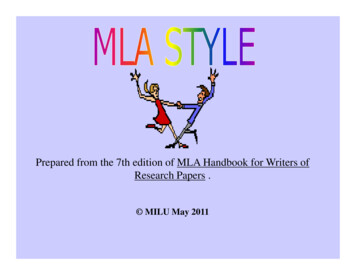
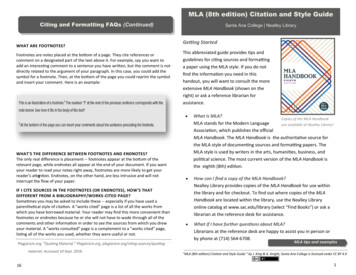

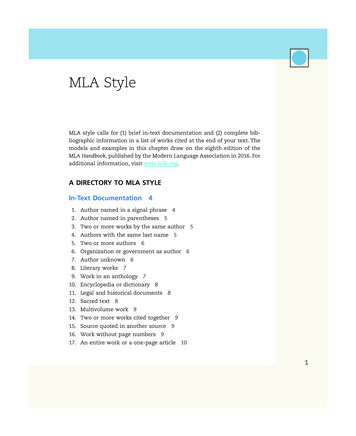
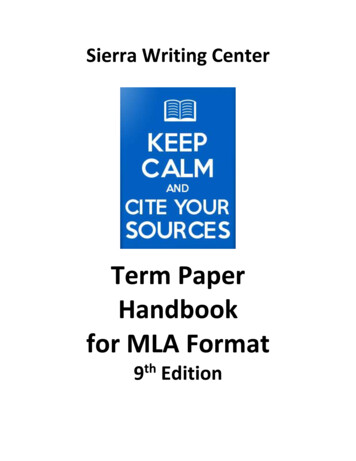
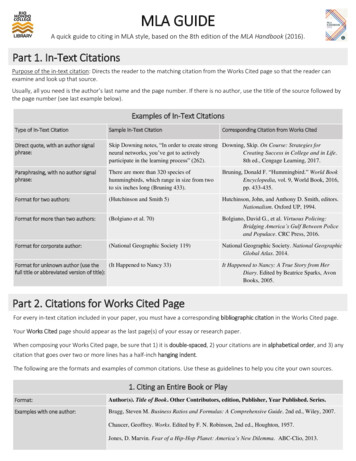
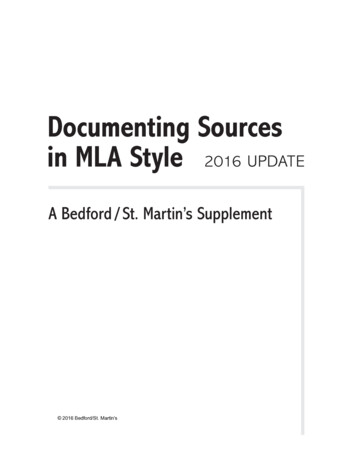
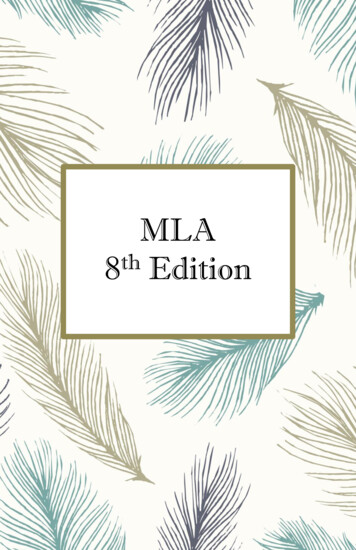
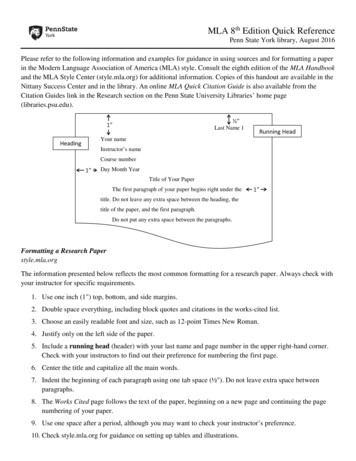
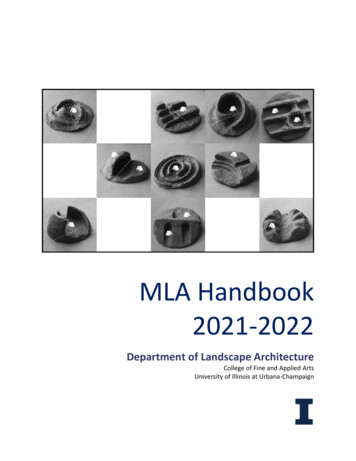
![[MS-ADFSOD]: Active Directory Federation Services (AD FS .](/img/1/5bms-adfsod-5d.jpg)